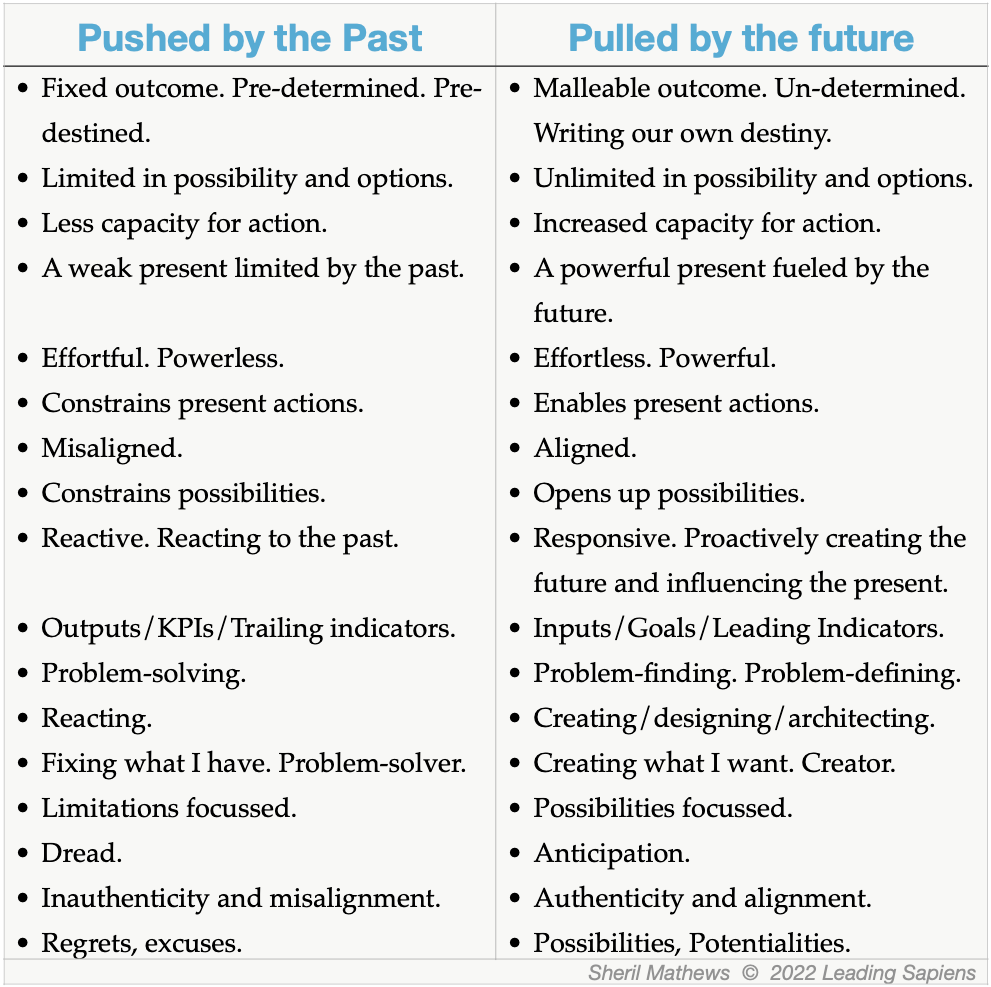The framework of a “future pulling us towards it” vs a “past pushing us” can be helpful in breaking out of a rut we find ourselves in.
Most of us have come across the concept of creating or imagining a compelling future. But why bother? Aren’t we smart enough to do what we know needs done?
Why do we need props like vision, mission statement, and goals?
Life can be pulled by goals just as surely as it can be pushed by drives.
– Viktor Frankl
A passive vs an active stance
There is a subtle but important distinction when we compare the difference between being “pushed by the past ” and being “pulled towards a designed future”.
One stance is proactive and actively reaching towards, whereas the other is reactive and passive. One is being a cause in, whereas the other is being an effect of. In one, we are being pulled from ahead whereas in the other we are being pushed from behind.
Is our future something we are getting pulled towards? Or is our past just pushing us along? In one, we are the object being subject to all the vagaries of life. In the other, we are the subject and being the cause in the matter of our lives.
It is a poor sort of memory that only works backwards.
— Lewis Caroll
Are we trodding along being pushed by the past or are we galloping being pulled by the future? What is the primary context for our actions in the present moment? Is it the past looming large or is it the possibilities of the future?
When in a funk, we should check what kind of future we have envisioned for ourselves? Is it pulling us towards it or are we just being pushed around by the exigencies of life?
Are we getting pushed down from the weight of the past or are we getting pulled up by the possibility of the future?
Default future vs defined future
The only thing we know about the future is that it will be different. Trying to predict the future is like trying to drive down a country road at night with no lights while looking out the back window.
The best way to predict the future is to create it.
– Peter Drucker
While the past cannot be rewritten it can be reinterpreted. And while the future is yet unwritten, there is a version of the future that we have already written by default. This default is the logical extension of our past. The questions is whether that is the future we want to live into or not? [1]
The trick is knowing that it is after all one version of several possible futures and that we have access to these futures through language. We can start rewriting and reconceptualizing that future.
And a different future will have different present actions and choices associated with it. Thus, by rewriting your future you rewrite your present and in turn end up with a different future instead of the default future.
Different orientations, different stances

Questions to ask ourselves
- Is my future playing a larger role than my past?
- Am I letting the past dictate my present or am I architecting a future that’s driving my present actions?
- If I don’t change anything, what does the default future look like? Is the future, that I am living into by default, something that I actually want?
- What are the stories that I have about my past? Can these be reinterpreted?
- What are the stories I have about my future? Can these be rewritten?
- Are my actions in the present moment consistent with my conception of the future?
Everything begins with the future!
– Martin Heidegger in Zollikon lectures [2]
Are we being the cause in our lives or are we at the mercy of everything that’s happening around us?
While we cannot be the cause in everything, we can be the cause in our own lives by taking responsibility for our choices and our role in shaping the future. And that is all we have access to.
Practicing future-based thinking
A useful to get better at future driven thinking is the systems thinking iceberg model that delves into deeper levels of reality instead of just the visible surface levels one we spend all our energy on.

Footnotes/References
- Three Laws of Performance by Steve Zaffron and Dave Logan.
- Zollikon Seminars by Martin Heidegger and Medard Boss.


